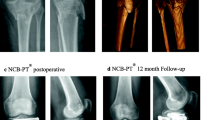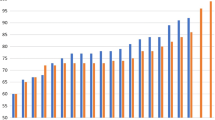Abstract
Purpose
The purpose of this study was to determine whether a polyaxial locking plate of the latest generation (NCB PT®, Zimmer Inc.) which can be applied both open and minimally invasively, can be used as a routine method of treatment for proximal tibia fractures.
Methods
Eighty-six patients (35 women, 51 men; mean age 51 years) were enrolled in this prospective multicentre trial. Ninety-six percent of the fractures were intra-articular (AO type B and C); 36 % were treated open and 64 % minimally invasively. Follow-up was obtained three, six and 12 months after surgery.
Results
No implant failure occurred. At 12 months, the functional result using a knee-specific score was good to excellent in 95 %, and 99 % of the fractures were radiologically healed.
Conclusion
The system is a versatile implant for proximal tibia fracture treatment. Polyaxiality and a specific locking mechanism are compatible with different fracture patterns. The minimally invasive technique effectively protects soft tissues but should not be performed at the expense of fracture reduction. Early functional results and complication rate are comparable to those in the literature.





Similar content being viewed by others
References
Dirschl DR, Dawson PA (2004) Injury severity assessment in tibial plateau fractures. Clin Orthop Relat Res 423:85–92
Rademakers MV, Kerkhoffs GM, Sierevelt IN, Raaymakers EL, Marti RK (2007) Operative treatment of 109 tibial plateau fractures: five- to 27-year follow-up results. J Orthop Trauma 21(1):5–10. doi:10.1097/BOT.0b013e31802c5b51
Jiang R, Luo CF, Wang MC, Yang TY, Zeng BF (2008) A comparative study of less invasive stabilization system (LISS) fixation and two-incision double plating for the treatment of bicondylar tibial plateau fractures. Knee 15(2):139–143. doi:10.1016/j.knee.2007.12.001
Tejwani NC, Hak DJ, Finkemeier CG, Wolinsky PR (2006) High-energy proximal tibial fractures: treatment options and decision making. Instr Course Lect 55:367–379
Biggi F, Di Fabio S, D’Antimo C, Trevisani S (2010) Tibial plateau fractures: internal fixation with locking plates and the MIPO technique. Injury 41(11):1178–1182. doi:10.1016/j.injury.2010.08.001
Reynders P (2009) Open acute segmental tibial fracture fixation using the less invasive stabilization system (LISS): study of 23 consecutive cases. Injury 40(4):449–454. doi:10.1016/j.injury.2008.09.007
Boldin C, Fankhauser F, Hofer HP, Szyszkowitz R (2006) Three-year results of proximal tibia fractures treated with the LISS. Clin Orthop Relat Res 445:222–229. doi:10.1097/01.blo.0000203467.58431.a0
Stevens DG, Beharry R, McKee MD, Waddell JP, Schemitsch EH (2001) The long-term functional outcome of operatively treated tibial plateau fractures. J Orthop Trauma 15(5):312–320
Partenheimer A, Gosling T, Muller M, Schirmer C, Kaab M, Matschke S, Ryf C, Renner N, Wiebking U, Krettek C (2007) Management of bicondylar fractures of the tibial plateau with unilateral fixed-angle plate fixation. Unfallchirurg 110(8):675–683. doi:10.1007/s00113-007-1271-1
Erhardt JB, Grob K, Röderer G, Hoffmann A, Forster TN, Kuster MS (2008) Treatment of periprosthetic femur fractures with the non-contact bridging plate: a new angular stable implant. Arch Orthop Trauma Surg 128(4):409–416. doi:10.1007/s00402-007-0396-6
Röderer G, Erhardt J, Graf M, Kinzl L, Gebhard F (2011) Clinical results for minimally invasive locked plating of proximal humerus fractures. J Orthop Trauma 24(7):400–406. doi:10.1097/BOT.0b013e3181ccafb3
Pressmar J, Macholz F, Merkert W, Gebhard F, Liener UC (2010) Results and complications in the treatment of periprosthetic femur fractures with a locked plate system. Unfallchirurg 113(3):195–202. doi:10.1007/s00113-009-1665-3
Lobenhoffer P, Gerich T, Bertram T, Lattermann C, Pohlemann T, Tscheme H (1997) Particular posteromedial and posterolateral approaches for the treatment of tibial head fractures. Unfallchirurg 100(12):957–967
Ranawat CS, Shine JJ (1973) Duo-condylar total knee arthroplasty. Clin Orthop Relat Res 94:185–195
Gandek B, Ware JE, Aaronson NK, Apolone G, Bjorner JB, Brazier JE, Bullinger M, Kaasa S, Leplege A, Prieto L, Sullivan M (1998) Cross-validation of item selection and scoring for the SF-12 health survey in nine countries: results from the IQOLA Project. International Quality of Life Assessment. J Clin Epidemiol 51(11):1171–1178
Higgins TF, Kemper D, Klatt J (2009) Incidence and morphology of the posteromedial fragment in bicondylar tibial plateau fractures. J Orthop Trauma 23(1):45–51. doi:10.1097/BOT.0b013e31818f8dc1
Abdel-Hamid MZ, Chang CH, Chan YS, Lo YP, Huang JW, Hsu KY, Wang CJ (2006) Arthroscopic evaluation of soft tissue injuries in tibial plateau fractures: retrospective analysis of 98 cases. Arthroscopy 22(6):669–675. doi:10.1016/j.arthro.2006.01.018
Cole PA, Zlowodzki M, Kregor PJ (2003) Compartment pressures after submuscular fixation of proximal tibia fractures. Injury 34(Suppl 1):A43–A46
Gaudinez RF, Mallik AR, Szporn M (1996) Hybrid external fixation of comminuted tibial plateau fractures. Clin Orthop Relat Res 328:203–210
Koval KJ, Sanders R, Borrelli J, Helfet D, DiPasquale T, Mast JW (1992) Indirect reduction and percutaneous screw fixation of displaced tibial plateau fractures. J Orthop Trauma 6(3):340–346
Gosling T, Schandelmaier P, Muller M, Hankemeier S, Wagner M, Krettek C (2005) Single lateral locked screw plating of bicondylar tibial plateau fractures. Clin Orthop Relat Res 439:207–214
Mueller KL, Karunakar MA, Frankenburg EP, Scott DS (2003) Bicondylar tibial plateau fractures: a biomechanical study. Clin Orthop Relat Res 412:189–195. doi:10.1097/01.blo.0000071754.41516.e9
Higgins TF, Klatt J, Bachus KN (2007) Biomechanical analysis of bicondylar tibial plateau fixation: how does lateral locking plate fixation compare to dual plate fixation? J Orthop Trauma 21(5):301–306. doi:10.1097/BOT.0b013e3180500359
Liu F, Tao R, Cao Y, Wang Y, Zhou Z, Wang H, Gu Y (2009) The role of LISS (less invasive stabilisation system) in the treatment of peri-knee fractures. Injury 40(11):1187–1194. doi:10.1016/j.injury.2009.03.012
Conflict of interest
The institutions received financial reimbursement from Zimmer, Inc. for conducting this follow-up. None of the authors received financial reimbursement or anything of value for conducting this follow-up. The last author is an instructional lecturer for trauma courses at the Zimmer Institute™.
Author information
Authors and Affiliations
Corresponding author
Rights and permissions
About this article
Cite this article
Jöckel, J.A., Erhardt, J., Vincenti, M. et al. Minimally invasive and open surgical treatment of proximal tibia fractures using a polyaxial locking plate system: a prospective multi-centre study. International Orthopaedics (SICOT) 37, 701–708 (2013). https://doi.org/10.1007/s00264-013-1820-x
Received:
Accepted:
Published:
Issue Date:
DOI: https://doi.org/10.1007/s00264-013-1820-x




